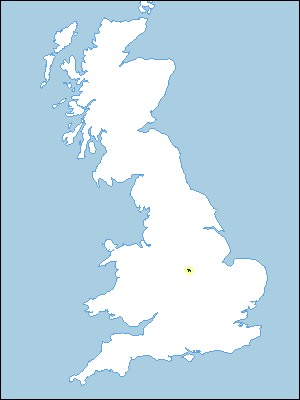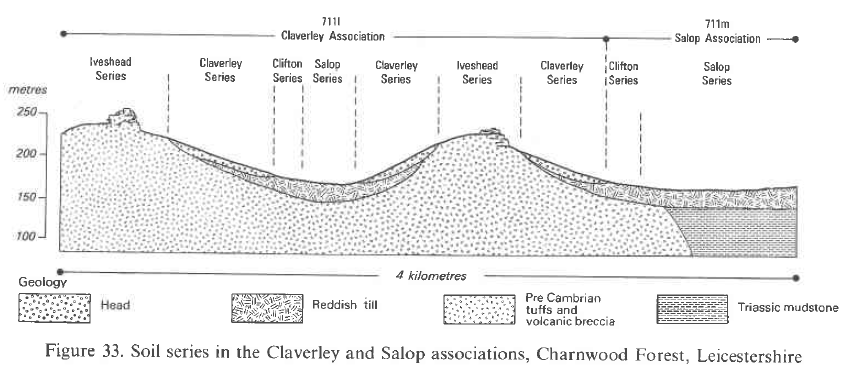
Soil Associations
0711l CLAVERLEY
Soil and site characteristics
Slowly permeable seasonally waterlogged reddish coarse and fine loamy soils. Associated with shallow stony well drained soils on brows and steep slopes where bare rock is common.
Geology
Reddish drift over acid igneous rock
Cropping and Land Use
Stock rearing on permanent grassland, some cereals and coniferous woodland.
Component soil series
| Subgroup | Series name | Percentage | WRB 2006 link |
|---|---|---|---|
| 7.11 | CLAVERLEY | 40% | Chromic Eutric Albic Luvic Stagnosols |
| 6.11 | IVESHEAD | 18% | Dystric Chromic Endoleptic Cambisols |
| 7.11 | CLIFTON | 7% | Chromic Eutric Albic Luvic Stagnosols |
| 7.11 | SALOP | 7% | Chromic Eutric Albic Luvic Stagnosols |
Covers 59 km2 in England and Wales
Soilscapes Classification
| 17 |
Slowly permeable seasonally wet acid loamy and clayey soils |
0711l CLAVERLEY
Detailed Description
The Claverley association, covering 64 km², is confined to Charnwood Forest in Leicestershire where Claverley series, typical stagnogley soils, and Iveshead series, typical brown podzolic soils, are dominant. The distinctive upland landscape of craggy outcrops of Pre-Cambrian igneous and metamorphic rocks rises to 278 m O.D. through the surrounding reddish tills and Triassic rocks. The soil pattern is closely related to topography. Iveshead soils, which are often interspersed with rock outcrops, are found on ridge crests or steep valley sides. They are very stony, well drained loamy soils with strong brown subsoil horizons over igneous rock. On lower gentle and moderate slopes, Claverley soils are developed in a thick locally-derived Head overlying and intermixed with reddish till. Claverley soils have coarse loamy upper horizons containing large igneous stones, and have a grey mottled subsurface horizon over a loamy but slowly permeable reddish subsoil. There are ancillary typical stagnogley soils, Salop and Clifton series , where the coarse upper drift thins over the till. These slowly permeable mottled soils are similar to the Claverley series but of finer texture and contain fewer large igneous stones. On convexities on the middle and lower slopes there are occasional typical brown earths of similar texture, drainage status and stoniness to Iveshead soils. The soil pattern described above is consistent but locally there are small areas dominated by Salop or Rufford series with patches of Whimple, Worcester, Brockhurst and Dunnington Heath soils on Triassic mudstones. Stony cambic gley soils are found in Head on the floors of small valleys and small patches of glaciofluvial drift carry Wick or Arrow soils. South of High Sharpley and elsewhere on some wet unimproved sites, Claverley topsoils are humose.
Soil Water Regime
The permeable Iveshead soils are well drained (Wetness Class I). In contrast, Claverley soils have slowly permeable subsoils which impede vertical water movement so they are waterlogged (Wetness Class IV) but, with their moderate porosity to at least 50 cm depth, seepage from higher land. Where undrained, Claverley soils are normally seasonally waterlogged (Wetness Class IV) but, with their moderate porosity, to at least 50 cm depth, they respond well to conventional drainage, becoming less frequently waterlogged (Wetness Class III). With permeability restricted at depth over much of the land, the Claverley association does not have a large potential for absorbing winter rain.
Cropping and Land Use
Charnwood Forest has a poorer climate than the surrounding lowlands. Rainfall is high (700-820 mm annually) and there is a long field capacity period (160-205 days). Other limitations are steep slopes and the stoniness of Iveshead soils. Stones cause excessive wear on implements, damage cutting machinery and restrict the depth of ploughing. Most Iveshead soils are under pasture and have good drainage, trafficability and relative freedom from poaching. Stock can be put out early or late in the season. Occasional kale and barley crops are grown. Where rock outcrops are common the opportunity for agricultural improvement is limited and such land is often used for amenity or rough grazing. Claverley soils have more potential than those of the Iveshead series but are best suited to grass production. A medium retained water capacity and a low bearing strength when at or near field capacity limits early and late grazing but the soils hold a good reserve of water (160 mm) to carry grass through the summer. Sustained arable use is only successful where drainage has been improved but even then spring cultivations are impossible without structural damage in most years. Stoniness, particularly occasional very large stones, hinders cultivations and precludes root crops. Both soils are naturally acid and require regular liming. Both are naturally rather poor in potassium and phosphorus. Phosphorus status is difficult to raise on Iveshead soils because of the tendency of podzols to fix phosphorus in a form generally unavailable to plants. Charnwood Forest was once extensively wooded and forestry is still significant although it covers only a tenth of the land. Most of the woodlands have been replanted with Scots pine, Japanese and European larch and Norway spruce, but a few semi-natural woods remain. Swithland Wood is of particular interest with sessile oak and birch on the more acid Claverley and Iveshead soils and pedunculate oak and ash on the better soils of the adjacent Dunnington Heath association. Several Sites of Special Scientific Interest and three nature reserves are located on the Claverley association. Because it is near Leicester, the attractive landscape of Charnwood Forest also has an important recreational role. There are public access areas at Beacon Hill, Bradgate Park, Outwoods and Swithland Wood.
0711l CLAVERLEY
Distribution Map
 |
Note that the yellow shading represents a buffer to highlight the location of very small areas of the association.
Keys to component soil series
Midlands
 |
Typical Landscapes
Midlands
 |
All information Copyright, Cranfield University © 2025
Citation: To use information from this web resource in your work, please cite this as follows:
Cranfield University 2025. The Soils Guide. Available: www.landis.org.uk. Cranfield University, UK. Last accessed 04/04/2025
